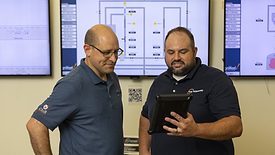Articles by Wayne Labs
While there are already some AI tools available, proving their effectiveness will take some dedicated teamwork from suppliers, integrators and manufacturers.
Read More
Food Safety
Getting Pressure to Remove the Heat?
High-pressure processing—or cold pasteurization—can be a significant investment, but if your product is perceived as organic, high-end, minimally processed and nutritional, it may well be worth the investment.
December 26, 2023
Track and Trace
Tracking Distribution Through Data: Who Should See What?
Today’s tracking tools can produce a lot of data, but the challenge is to provide the right data to users and to regulatory bodies.
December 21, 2023
Have a Strategy in Place…Or Put Out Fires, Maybe Literally
Even with the best strategy and sensors in place, the final result comes down to humans making the right decision.
November 30, 2023
Deploy Mobile Devices on the Plant Floor to Maximize Operator Efficiency
Mobile devices give operators freedom to move about, but user interface design needs careful thought before implementation.
November 28, 2023
SUSTAINABILITY
Develop a Plan of Attack to Save Energy
As energy becomes more expensive, formulate a plan to look at and meter all plant utilities—then take action to curb energy usage.
October 18, 2023
Automation Technology
Blockchain Technology: Slow on the Uptake?
Blockchain technology could solve a lot of food safety and supply chain problems, but acceptance has been relatively slow in the U.S.
October 11, 2023
Getting a Handle on Software Compatibility Issues
Easier said than done, but compared to ten years ago, today’s tools in knowledgeable hands make connecting software a lot easier.
September 28, 2023
Processing Technology
Analytical Instrumentation: When Exacting Information is Needed
Whether it’s maintaining quality or proving authenticity, precise measurements provide the data to make informed decisions.
September 15, 2023
Elevate your expertise in food engineering with unparalleled insights and connections.
Get the latest industry updates tailored your way.
JOIN TODAY!Copyright ©2025. All Rights Reserved BNP Media.
Design, CMS, Hosting & Web Development :: ePublishing









